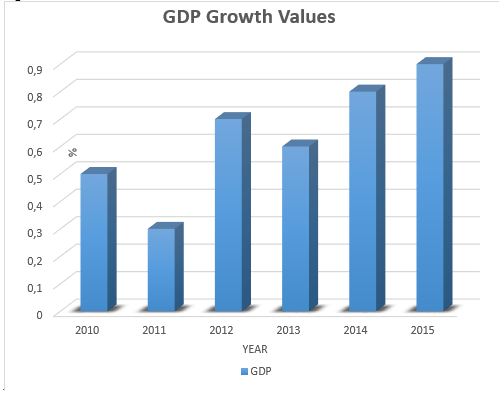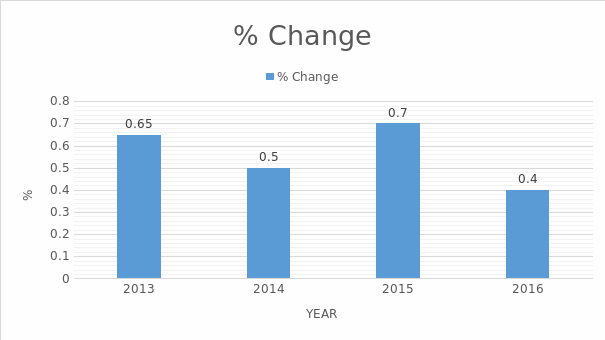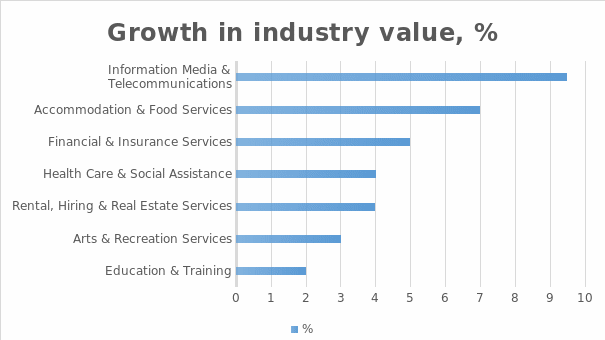Introduction
Australia is one of the countries that possess numerous valuable and rather expensive resources. It distributes treasured raw materials and farmhouse products worldwide. Numerous categories of resources are produced. Nevertheless, the majority of those resources lie well far-off from larger metropolises or waterfronts. More than half of Australia is the countryside, which is predominantly used to raise livestock.
Farmers can cultivate wheat all over the country since it does not require much precipitation. Only a small part of the populace are agriculturalists, but they practically provide the whole lot that the country requests. Another industry that has become very important later for the economy of Australia is tourism (Pham et al. 610). Nevertheless, trips to Australia are rather expensive for the reason that it is too far from the other major countries.
Agricultural Growth
Australia is currently seeing a substantial short-run agricultural growth. Most of the responsibility for the upsurge lies on the technological advancement of the industry that drives the growth and productivity. Noteworthy instances of long-run growth changes comprise the adoption of no-till agriculture based on the usage of harmless herbicides, which significantly condensed input expenses, reserved more soil dampness, and enhanced crop harvest; and the use of underground clover in some of Australian cattle systems which enhanced soil productiveness and amplified cattle growth rates (Anderson and Strutt 592).
Additional enhancements gave rise to the supplementary manufacture gains through the upgraded water use efficacy, pressure tolerance, feedstuff adaptation proficiency, and product value. The process of growth is reflected in Figure 1.

Approximately half of the growth could be accredited to the modernization of the farms as it was projected to have improved farmers’ business cost-effectiveness. The agricultural sector contributes a total of 2% of the overall GDP growth of Australia but still represents an important part of the country’s economy (Sheng et al. 30). Australian agriculturalists have made confident changes to the pesticide implementation in their farmer practice and improved their understanding of the issue. Farmers are now more aware of the influence of pesticides on the agriculture and quality of the final product, but some of them still do not deliver the necessary level of individual safety standards that should be in compliance with the governmental law on the use of such substances.
Industrial Growth
In its geographical area, the Australian business segment is already solid, but the trade will remain growing. So the highest growth rates are expected to be in the fragments of the industry strictly associated with other growing subdivisions. One of the main sectors that one should pay attention to is the retail trade (Hatfield-Dodds et al. 49). The retail trade growth can be seen in Figure 2.

The key industries that have seen the most growth in June 2016 are snack bars, cafés, and other food facilities. The least growth was spotted in the segments of fashion, footwear, accessories trade, and division markets. There were also trends that went on fairly unaffected in trend standings in June 2016. These include food trade and domestic goods-vending. Several Australian territories, including The Northern Territory, cut down in trend standings in June 2016.
The industrial sector brings significant change to the overall GDP. Its contribution is valuable and reflects the general standing of the current trade tendencies. The majority of the sector sees monthly visible improvements and is affected by the influential businesses leading the market (Salahuddin and Alam 872). The Government is presently redeploying the industry strategy to encourage private enterprise and modernization. Industry strategies will be reorganized to make the most of Australia’s strong points and fast-track the development projections of the potentially profitable small- and medium-sized businesses and most auspicious industry segments. The Government will enable captivating policies by businesses that take the risk and devote their own resources.
Services Growth
The assorted array of industries defined as ‘services’ justifies nearly 4/5 of working opportunities and about 3/5 of overall GDP. The services segment raised soundly during the last year in proportion to the overall manufacturing growth (2,5%). Figure 3 shows the growing rates of Australia’s important services areas and reflects a wide disproportion within the segment.
Information Media & Telecommunications logged the quickest development rates of any service area during the last year, with trade productivity growing by 9 percent. The segment comprises the bigger part of the Information & Communications Technology section, but correspondingly embraces media essentials such as television, radio set, tabloids, and public libraries (“Social Media and Digital Technology Use” par. 8).

The subdivision’s robust current performance and its major contribution to Australian GDP are credited to businesses’ growing use of IT services to compete effectually. The Government states that the country, in general, has as well profited from this quick industrial transformation and moved on to innovative business concepts.
Evaluation
All three of the sectors reviewed in the paper are important to Australia’s economy. Even though the general GDP growth is much small in the agricultural sector, this segment is still vital for the country. If we compare these sectors, it is obvious that the services sector brings the most profit and is the most rapidly growing from all three. More and more companies and governmental organizations pay attention to this sector. The future productivity prospects prove to be positive. This assumption is based on the careful assessment of the obtained data and studied literature. The growth is consistent, and the trend should continue.
Policy Implications
The findings of this study show that Australian economy is on the rise, and this tendency is unavoidable. All the industries are influenced by the improvements and modifications made by the Government in agriculture, industries, and services. I would recommend stressing the importance of the use of informational technologies. We live in the age of media, so it is essential to follow the trend and adapt to the current innovations and modernize all the spheres of business to gain more profit and recognition.
Works Cited
Anderson, Kym, and Anna Strutt. “Emerging Economies, Productivity Growth and Trade with Resource-rich Economies by 2030.” Australian Journal of Agricultural and Resource Economics 58.4 (2014): 590-606. Web.
Hatfield-Dodds, Steve, Heinz Schandl, Philip D. Adams, Timothy M. Baynes, Thomas S. Brinsmead, Brett A. Bryan, Francis H. S. Chiew, Paul W. Graham, Mike Grundy, Tom Harwood, Rebecca Mccallum, Rod Mccrea, Lisa E. Mckellar, David Newth, Martin Nolan, Ian Prosser, and Alex Wonhas. “Australia Is ‘Free to Choose’ Economic Growth and Falling Environmental Pressures.” Nature 527.7576 (2015): 49-53. Web.
Pham, Tien, Leo Jago, Ray Spurr, and Justin Marshall. “The Dutch Disease Effects on Tourism – The Case of Australia.” Tourism Management 46 (2015): 610-22. Web.
Rice, Emma S., Emma Haynes, Paul Royce, and Sandra C. Thompson. “Social Media and Digital Technology Use Among Indigenous Young People in Australia: A Literature Review.” International Journal for Equity in Health 15.1 (2016): n. pag. Web.
Salahuddin, Mohammad, and Khorshed Alam. “Internet Usage, Electricity Consumption and Economic Growth in Australia: A Time Series Evidence.” Telematics and Informatics 32.4 (2015): 862-78. Web.
Sheng, Yu, Shiji Zhao, Katarina Nossal, and Dandan Zhang. “Productivity and Farm Size in Australian Agriculture: Reinvestigating the Returns to Scale.” Australian Journal of Agricultural and Resource Economics 59.1 (2014): 16-38. Web.